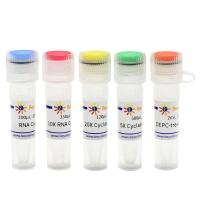Circular Dichroism to Study Protein Interactions
互联网
- Abstract
- Table of Contents
- Figures
- Literature Cited
Abstract
Circular dichroism (CD) is a powerful technique for studying the structures of proteins in solution, as well as structural changes that may occur when proteins bind to ligands. Changes in CD signals accompanying complex formation can be used to determine the strength of the interaction and to provide information about the nature and extent of the conformational changes involved. This unit outlines the type of information available from CD studies and describes how such experiments should be carried out to ensure that reliable information is obtained.
Keywords: circular dichroism; protein structure; conformational change; ligand binding
Table of Contents
- Strategic Planning
- Basic Protocol 1: CD Titration to Monitor Binding
- Basic Protocol 2: Analysis of CD Data to Determine Binding Constants
- Support Protocol 1: Analysis of Far‐UV CD Data to Determine Secondary Structure Content
- Support Protocol 2: Assessment of Stability of Protein During Titration
- Support Protocol 3: Choice of Buffer and Solvent System
- Support Protocol 4: Determination of Protein Concentration
- Support Protocol 5: Calibration of CD Instrument
- Support Protocol 6: Choice of Instrument Parameters
- Commentary
- Literature Cited
- Figures
- Tables
Materials
Figures
-
Figure 20.10.1 CD spectra of the molybdate‐sensing protein ModE from E. coli in the absence (solid line) and presence (dashed line) of 1 mM molybdate. Panels A and B represent the near‐UV and far‐UV CD spectra, respectively. The data are adapted from Anderson et al. () and Boxer et al. (). View Image -
Figure 20.10.2 Far‐UV CD spectra of the adenylyl cyclase toxin of Bordetella pertussis (CyaA) in the absence (solid line) and presence (dashed line) of 1 mM calcium chloride. The data are adapted from Cheung et al. (unpub. observ.). View Image -
Figure 20.10.3 Analysis of binding data. Panel A illustrates nonlinear fitting to Equation . The resultant values are Δθmax = 15.97 mdeg (standard error 0.03 mdeg), and K d = 34.9 µM (standard error 0.2 µM). Panel B shows a Scatchard plot according to Equation . In this plot, the slope = −1/ K d ; hence, K d can be calculated to be 35 µM. The intercept on the y ‐axis = Δθmax ; hence, Δθmax = 16 mdeg. Whereas the nonlinear fitting is useful for indicating the errors in the estimates of the binding parameters, the Scatchard plot can indicate whether there are systematic deviations from the hyperbolic binding model. In this example, the ligand concentration is assumed to be much larger than that of the protein, so that [L]free can be set equal to [Lt ] in the plots. View Image -
Figure 20.10.4 Analysis of specimen binding data using the Hill plot according to Equation . The slope of the plot is the Hill coefficient; this can be calculated to be 2.5, indicating a significant degree of cooperativity in ligand binding. From the point of intersection of line with the x ‐axis, the value of K can be calculated to be 5500 µM (Equation ). View Image
Videos
Literature Cited
| Anderson, L.A., Palmer, T., Price, N.C., Bornemann, S., Boxer, D.H., and Pau, R.N. 1997. Characterisation of the molybdenum‐responsive ModE regulatory protein and its binding to the promoter region of the modABCD (molybdenum transport) operon of Escherichia coli. Eur. J. Biochem. 246:119‐126. | |
| Baldwin, G.S., Kelly, S.M., Price, N.C., Wilson, G.W., Connolly, B.A., and Hornby, D.P. 1994. Ligand‐induced conformational states of a deoxy‐cytidine specific DNA methyltransferase. J. Mol. Biol. 235:545‐553. | |
| Boxer, D.H., Zhang, H., Gourley, D.G., Hunter, W.N., Kelly, S.M., and Price, N.C. 2004. Sensing of remote oxyanion binding at the DNA binding domain of the molybdate‐dependent transcription regulator, ModE. Org. Biomol. Chem. 2:2829‐2837. | |
| Cooper, A. and Johnson, C.M. 1994. Isothermal titration microcalorimetry. Methods Mol. Biol. 22:137‐150. | |
| Drake, A.F. 2001. Circular dichroism. In Protein‐Ligand Interactions: Structure and Spectroscopy (S.E. Harding and B.Z. Chowdhry, eds.) pp. 123‐167. Oxford University Press, New York. | |
| Gill, S.C. and von Hippel, P.H. 1989. Calculation of protein extinction coefficients from amino acid sequence data. Anal. Biochem. 182:319‐326. | |
| Greenfield, N.J. 2004a. Circular dichroism analysis for protein‐protein interactions. Methods Mol. Biol. 261:55‐78. | |
| Greenfield, N.J. 2004b. Analysis of circular dichroism data. Methods Enzymol. 383:282‐317. | |
| Haupt, G.W. 1952. An alkaline solution of potassium chromate as a transmittancy standard in the ultraviolet. J. Res. Natl. Bur. Stand. 48:414‐423. | |
| Hornby, D.P., Whitmarsh, A., Pinabarsi, H., Kelly, S.M., Price, N.C., Shore, P.D., Baldwin, G.S., and Waltho, J. 1994. The DNA recognition subunit of a DNA methyltransferase is predominantly a molten globule in the absence of DNA. FEBS Lett. 355:57‐60. | |
| Kelly, S.M., Jess, T.J., and Price, N.C. 2005. How to study proteins by circular dichroism. Biochim. Biophys. Acta 1751:119‐139. | |
| Lobley, A., Whitmore, L., and Wallace, B.A. 2002. DICHROWEB: An interactive Website for the analysis of protein secondary structure from circular dichroism spectra. Bioinformatics 18:211‐212. | |
| Matthews, J.R., Nicolson, J., Jaffray, E., Kelly, S.M., Price, N.C., and Hay, R.T. 1995. Conformational changes induced by DNA binding of NF‐κB. Nucl. Acids Res. 23:3393‐3402. | |
| McDonnell, J.M. 2001. Surface plasmon resonance: Towards an understanding of the mechanisms of biological molecular recognition. Curr. Opin. Chem. Biol. 5:572‐577. | |
| Munro, A.W., Lindsay, J.G., Coggins, J.R., Kelly, S.M., and Price, N.C. 1994. Structural and enzymological analysis of the interaction of isolated domains of cytochrome P‐450 BM3. FEBS Lett. 343:70‐74. | |
| Munro, A.W., Lindsay, J.G., Coggins, J.R., Kelly, S.M., and Price, N.C. 1996. Analysis of the structural stability of the multidomain enzyme flavocytochrome P‐450 BM3. Biochim. Biophys. Acta 1296:127‐137. | |
| Pace, C.N., Vajdos, F., Fee, L., Grimsley, G., and Gray, T. 1995. How to measure and predict the molar absorption coefficient of a protein. Prot. Sci. 4:2411‐2423. | |
| Rose, T., Sebo, P., Bellalou, J., and Ladant, D. 1995. Interaction of calcium with Bordetella pertussis adenylate cyclase toxin. J. Biol. Chem. 270:26370‐26376. | |
| Schmid, F.X. 1989. Spectral methods of characterizing protein conformation and conformational changes in protein structure. In Protein Structure: A Practical Approach, (T.E. Creighton, ed.) pp. 252‐285. Oxford University Press, Oxford. | |
| Smith, L., Greenfield, N.J., and Hitchcock‐DeGregori, S.E. 1994. The effects of deletion of the amino‐terminal helix on troponin C function and stability. J. Biol. Chem. 269:9857‐9863. | |
| Sreerama, N. and Woody, R.W. 2004. Computation and analysis of protein circular dichroism spectra. Methods Enzymol. 383:318‐351. | |
| van Holde, K.E., Johnson, W.C., and Ho, P.S. 2006. Principles of Physical Biochemistry, 2nd ed. Chapter 14. Pearson Education, Upper Saddle River, N.J. | |
| Whitmore, L. and Wallace, B.A. 2004. DICHROWEB, an online server from protein secondary structure analyses from circular dichroism spectroscopic data. Nucl. Acids Res. 32:W668‐W673. | |
| Wien, F., Miles, A.J., Lees, J.G., Vronning Hoffmann, S., and Wallace, B.A., 2005. VUV irradiation effects on proteins in high‐flux synchrotron radiation circular dichroism spectroscopy. J. Synchrotron Radiat. 12:517‐523. | |
| Wood, S.P., Blundell, T.L., Wollmer, A., Lazarus, N.R., and Nevill, R.W.J. 1975. Relation of conformation and association of insulin to receptor binding. X‐ray and circular‐dichroism studies on bovine and hystricomorph insulins. Eur. J. Biochem. 55:531‐542. | |
| Internet Resources | |
| http://www.gla.ac.uk/ibls/pcf/circular_dichroism.htm | |
| The home page of the Scottish Circular Dichroism Facility contains an explanation of the theory and practice of CD and has links to other important CD sites. | |
| http://www.cryst.bbk.ac.uk/cdweb/html/home.html | |
| The DICHROWEB server for online analysis of far‐UV CD spectra (Lobley et al., ; Whitmore and Wallace, ). | |
| http://us.expasy.org/tools/protparam.html | |
| The ProtParam tool within the ExPASy Website calculates the extinction coefficient for a native protein according to the equation proposed by Pace et al. () (Equation ). Also see UNIT . |









